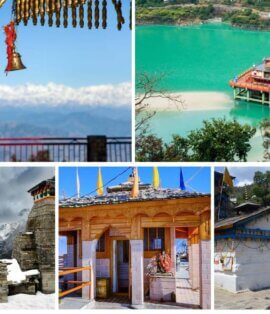Standing tall and majestic at about 50 feet, the sacred Badarinath Temple features a vibrant entrance called Singhdwar, making a striking first impression. Topped with a golden-gilded cupola, the temple is a divine symbol of spirituality and devotion. The temple is divided into three main sections:
- Garbha Griha (Sanctum Sanctorum) – The inner sanctum housing the deity.
- Darshan Mandap – The place where rituals and prayers are conducted.
- Sabha Mandap – An assembly area where pilgrims gather.
At the entrance, directly opposite the main idol, sits the idol of Garuda, Lord Vishnu’s sacred vehicle, shown in a posture of prayer. The intricate carvings on the walls and pillars of the temple reflect stunning craftsmanship.
Inside the Garbha Griha, the main deity Lord Badari Narayan is accompanied by idols of Kubera, Narada Rishi, Udhava, Nara, and Narayana. Especially captivating is the one-meter high black stone idol of Lord Badarinath, believed to have been discovered by Adi Shankaracharya in the Alaknanda River and later enshrined by the King of Garhwal in the 16th century.
In the Darshan Mandap, Lord Badari Narayan is depicted holding a conch and chakra in two raised arms, while the other two arms rest in a yogic pose. Important figures such as Kubera, Garuda, Narada Muni, Nara, and Narayana surround him, each adding to the temple’s spiritual vibrance.
The Sabha Mandap serves as the main congregation area for devotees.
History of Badarinath
The name Badarinath originates from Badari, a type of wild berry. According to legend, Goddess Lakshmi turned herself into a berry tree to shield Lord Vishnu during his meditation in the mountains.
Historical accounts say that Adi Guru Shankaracharya recovered the idol of Lord Badarinath from Narad Kund and re-enshrined it in the 8th century A.D. His mission was to revive Hinduism during a time when Buddhism was expanding across the Himalayas. Through efforts like establishing temples at sacred sites, Shankaracharya reestablished the spiritual significance of Hinduism.
The temple holds stories linked to the Pandavas on their final journey to heaven, Lord Krishna’s visits, and penances performed by sages like Nara and Narayana, Kapila Muni, Gautam, and Kashyap. Even today, the temple remains a beacon for sages, saints, and seekers of enlightenment.
The Skanda Purana aptly describes Badarinath as,
“There are several sacred shrines in heaven, on earth, and in hell; but there is no shrine like Badarinath.”
Climate and Best Time to Visit
Badarinath’s weather is marked by distinct seasons:
- Winter (October to April): Extremely cold with snowfall. Not ideal for travel.
- Summer (May to June): Pleasant and moderately cold. Best time for sightseeing and pilgrimage.
- Monsoon (July to mid-September): Rainy and risky due to slippery roads; check travel advisories.
The temple remains open from April/May to November each year.
| Month | Min Temp | Max Temp | Weather |
|---|---|---|---|
| January | 1°C | 8°C | Snowfall |
| May | 11°C | 22°C | Sunny |
| July | 11°C | 14°C | Rainy |
| October | 12°C | 17°C | Chance of Snowfall |
How to Reach Badarinath
By Air
- Nearest Airport: Jolly Grant Airport (Dehradun) – 314 km from Badarinath.
- Regular taxis available.
By Train
- Nearest Railway Station: Rishikesh – 295 km from Badarinath.
- Well connected with major Indian cities.
By Road
Badarinath is connected through National Highway 58 and is accessible by buses and taxis from major cities like Haridwar, Rishikesh, Dehradun, and Srinagar.
Popular Road Routes
- Kedarnath to Badarinath: Via Sonprayag, Rudraprayag, Karnaprayag (247 km).
- Haridwar/Rishikesh to Badarinath: (298-324 km) via Srinagar, Rudraprayag.
Facilities Near Badarinath
- ATM: SBI ATM near the temple.
- Petrol Pump: Available near the bus stand.
- Food Joints: Multiple food stalls and restaurants near the temple.
Attractions Around Badarinath
Sacred Rocks (Shilas)
- Narada Shila: Site of Narad Muni’s 60,000-year penance.
- Markandeya Shila: Associated with Sage Markandeya’s penance.
- Barahi Shila: Related to the slaying of the demon Hiranyaksha.
- Garud Shila: Where Garuda meditated for 30,000 years.
- Narsingh Shila: Linked to Lord Narsingh’s fierce avatar.
Holy Ponds (Kunds)
- Tapt Kund: Hot water spring situated between the shrine and Alaknanda River.
Other Attractions
- Brahma Kapal: Sacred place for performing rituals for ancestors (Pind Daan).
- Sheshnetra: Mythical eye of the serpent Shesha.
- Panch Dhara: Five sacred water streams originating from Badarinath.
Accommodation Options
- BKTC Guest Houses at Badarinath.
- Private Hotels and Dharamshalas near the temple.
- Accommodation at Joshimath: 45 km away; ideal for pilgrims who prefer staying at a lower altitude.
Conclusion
The Badarinath Temple is more than just a sacred destination—it is a confluence of spirituality, mythology, and breathtaking Himalayan beauty. Whether you are a devotee, a seeker, or an adventurer, a visit to Badarinath offers an unforgettable journey of inner peace, devotion, and awe-inspiring wonder.






